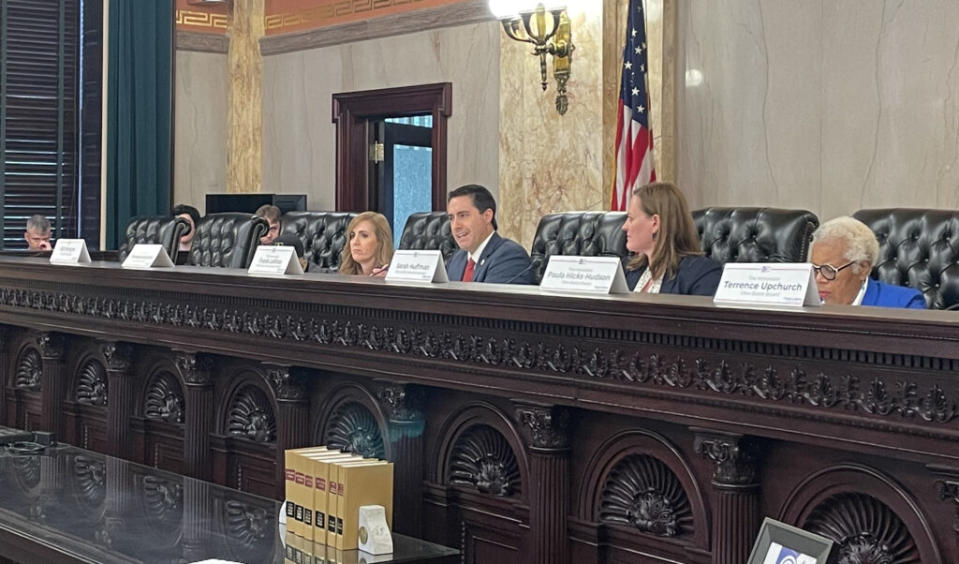Attorney Jyoti Jasrasaria speaking on behalf of the Ohio Voters Bill of Rights before the ballot board. (Photo by Nick Evans, Ohio Capital Journal.)
Ohio Secretary of State Frank LaRose and the state ballot board cleared supporters of a citizen-led initiative aimed at enshrining greater voting access in the state constitution to begin collecting signatures.
The board voted unanimously that The Ohio Voters Bill of Rights contains only one proposed amendment.
Advertisement
Advertisement
Had it decided differently, the board could’ve sent the petitioners back to the drawing board — splitting the amendment into pieces and forcing supporters to start over with new ballot summaries.
The Ohio Voters Bill of Rights
The proposed amendment would grant counties the ability to set up multiple early vote centers or ballot drop boxes, create a system to update voter registration automatically when someone visits the BMV, and allow for same day voter registration.
While the proposal accomplishes several different changes, supporters argued because all them relate to voting, the proposal represents a single amendment.
SUBSCRIBE: GET THE MORNING HEADLINES DELIVERED TO YOUR INBOX
Advertisement
Advertisement
“The Ohio Supreme Court has stated time and again that the ballot board has a clear legal duty to liberally construe the right of initiative,” petitioners’ attorney Jyoti Jasrasaria argued. “As long as the citizen initiated proposed amendment, there’s some reasonable relationship to a single general object or purpose, the board must certify its approval of the amendment as written without dividing it into multiple petitions.”
Although LaRose himself previously supported provisions like automatic voter registration, he sharply rebuked the proposed amendment when it was introduced last year.
“It’s a direct assault on the integrity of our voting process and the safeguards we’ve put in place to hold that process accountable,” LaRose insisted at the time.
During Monday’s meeting, he suggested the amendment seemed to cover three “broad subject areas,” including election administration, voter registration and the actual casting of ballots.
Advertisement
Advertisement
Jasrasaria pushed back, arguing past amendments, including a similar proposal from 2020 that never wound up making the ballot, cleared the board’s single amendment review without a problem.
“And I think the same applies here,” she said. “Because even though it covers both registration and casting ballots, that’s something that we see often even in comprehensive voting related legislation, which, of course, is subject to a strict single subject requirement under the Constitution.”

Ohio Secretary of Stte Frank LaRose speaking during an Ohio Ballot Board meeting. (Photo by Nick Evans, Ohio Capital Journal.)
LaRose also insisted the purpose of the meeting was to discuss whether the proposal constitutes a single amendment, rather than provide an opportunity to interrogate the content of the proposal.
He then proceeded to critique contents the proposal.
Advertisement
Advertisement
LaRose questioned the amendment for giving voters additional options for proving their identity at the polls, establishing same day registration, and likely eliminating Ohio’s annual removal of inactive voters — the so-called “supplemental process” critics often refer to as a voter purge.
Despite those misgivings, LaRose moved approve the proposal as a single amendment and the board unanimously agreed.
How the amendment got here and where it’s headed
The Ohio Voters Bill of Rights hasn’t had an easy path, though. Organizers tried a similar amendment in 2020 only to see their efforts derailed by the COVID-19 pandemic.
They introduced a new version last year under the same title “Secure and Fair Elections.” Attorney General Dave Yost rejected it. Among other complaints he said the title was “completely untethered to the actual substance of the proposed amendment.” He rejected the follow-up, too — now carrying the Ohio Voters Bill of Rights moniker — again, zeroing in on the amendment’s title.
Advertisement
Advertisement
But the state supreme court held that the AG can’t reject a measure based on the title alone. Following that ruling Yost cleared the amendment summary as a “fair and truthful” representation of its proposed changes.
Speaking after the hearing, Ohio Organizing Collaborative spokeswoman Bria Bennett said they weren’t surprised the board advanced their proposal.
“Because the Ohio Supreme Court previously has spoken that it should be a single amendment,” she said, “so they went along with the decision from our highest court.”
As for whether the Secretary’s quibbles offer a preview of the opposition they might face in a campaign, she acknowledged they might, but argued the text of their proposal will answer those complaints.
Advertisement
Advertisement
“This is not a short ballot (measure), she said. “This is very long. It has a lot of extensive language, but the goal is to make sure that our election process is secure, while also making sure that folks have the right and ability to vote.”
When they might actually see that amendment on the ballot remains uncertain. Although they’ve now cleared the initial administrative hurdles, organizers will need to collect hundreds of thousands of signatures from across Ohio to make it onto the ballot. Asked whether they’re aiming for 2025 or 2026, Bennett only said they’re “exploring what we’re going to do next.”
Follow OCJ Reporter Nick Evans on Twitter.
SUPPORT: YOU MAKE OUR WORK POSSIBLE
EMEA Tribune is not involved in this news article, it is taken from our partners and or from the News Agencies. Copyright and Credit go to the News Agencies, email news@emeatribune.com Follow our WhatsApp verified Channel




